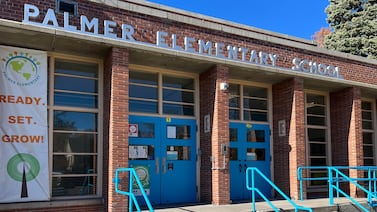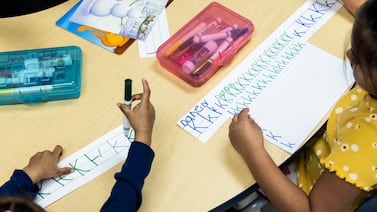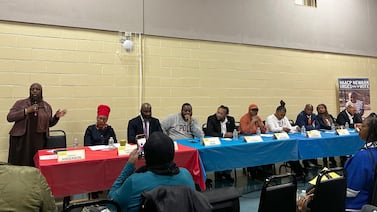Sign up for Chalkbeat New York’s free daily newsletter to get essential news about NYC’s public schools delivered to your inbox.
New York City schools are gearing up for a historic hiring spree as thousands more teachers are needed this fall to shrink class sizes across the five boroughs.
In a typical year, the city Education Department hires between 4,000 and 5,000 new teachers to fill gaps left by those who retire, move, or leave for other reasons. But by September, officials have recently said the city is aiming to hire between 7,000 and 9,000 new educators to meet a major class size deadline: bringing 60% of classrooms citywide under the caps mandated by the state’s sweeping class size law.
Currently, about 46% of classes comply with the law, which caps K-3 classes at 20 students, 4-8 classes at 23 students, and high school classes at 25. All classrooms must meet the limits by Sept. 2028.
The hiring boom presents both a major opportunity and an unprecedented challenge for city schools.
On one hand, hundreds of schools are likely to have more money than usual, guaranteed earlier in the year than is typical, to hire teachers, thanks to a new city initiative that allowed schools to apply for additional funding to lower class sizes. But the marked uptick in demand for teachers will also put a new strain on the city’s ability to recruit candidates — particularly amid an ongoing state and national teacher shortage.
The flood of new job postings is also expected to increase churn within the system as public school teachers leave their current placements for more desirable openings — a pattern administrators and officials fear will disproportionately harm schools that have traditionally had the hardest time hiring and retaining teachers, including high-poverty schools and those located in the Bronx and parts of Brooklyn.
“That volume is a lot, and we are actually concerned about meeting the volume,” said Amy Way, the executive director of the Education Department’s Office of Teacher Recruitment and Quality, earlier this month at a panel on teacher morale co-sponsored by EdWeek and Chalkbeat. “There really has been a decline in people entering the teaching profession.”
Some 750 schools submitted applications requesting a combined 4,000 additional teachers, officials said recently. Responses to the applications are expected as soon as this week despite the city’s initial promise to provide answers by February. United Federation of Teachers President Michael Mulgrew told teachers in an email last week that nearly 90% of schools that applied are expected to get some or all the funding they requested.
“This will be the first time ever that all these schools are going to be told…‘You will have the funding directly in your budgets for this,‘” Mulgrew said recently on the education podcast Talk Out of School. “You’re going to have hundreds of schools who are looking to hire early, way before June. So this is going to be an interesting dynamic for our school system.”
School leaders are preparing for a tumultuous few months.
“It’s going to be a bloodbath out there for hiring if all of these schools are getting all or some of the allotment they’re asking for,” said one Manhattan principal, who spoke on the condition of anonymity so as not to jeopardize his application. “Some schools are going to have a really hard time attracting teachers when you have really well-resourced schools in very accessible parts of the city hiring too.”
The Education Department already has some measures in place to increase the teacher pipeline and to mitigate the effects of churn within the system. Programs like NYC Men Teach and NYC Teaching Fellows have made strides in attracting more diverse candidates by offering extra support and an expedited path into the profession.
The city also offers some incentives to help fill historically hard-to-staff roles and schools, including monetary bonuses and early hiring privileges. The Education Department didn’t immediately respond to questions about which specific roles were eligible for bonuses, but a spokesperson pointed to a new teacher residency program funded by the state and career training for paraprofessionals seeking to become teachers.
“We’re acutely aware that we’ve got to make sure we up our game,” said First Deputy Chancellor Dan Weisberg at a recent town hall in Brooklyn’s District 19. “So we’re going to do even more going forward.”
Department spokesperson Jenna Lyle added Tuesday, “We are leaving no stone unturned.”
A supply and demand question
The most basic question facing the city as it prepares for its hiring spree is whether the supply of teachers can meet the demand.
New York City historically hasn’t been hit as hard as other parts of the state and country by teacher shortages thanks to the steady flow of people migrating to the five boroughs and the relatively high teacher salaries.
But the city isn’t immune to the challenges facing the profession. The teaching force shrunk during the pandemic thanks to higher levels of attrition and reduced hiring, though the Education Department said it grew by 1,000 teachers from last school year to this one. Several roles, including high school math and science, special education, and bilingual teachers remain chronically understaffed.
The number of students who completed traditional college teacher preparation programs in New York dropped from over 22,000 in 2012 to under 15,000 a decade later. And only 9,000 people across the entire state of New York received a new teaching certification in the 2018-19 school year, including those in traditional teacher prep and alternative certification programs, according to data city Education Department officials shared with the class size working group in 2023.
Supporters hope lower class sizes will be extra enticement. Some principals have already gotten interest from teachers in other parts of the state attracted by the prospect of the class size caps, according to a union source.
And if the city does manage to meet the elevated hiring demand, some administrators and experts are concerned that the quality of candidates could diminish. Some past research has suggested that the educational benefits of reduced class sizes are offset by a decline in teacher quality when schools are forced to staff up.
The elevated teacher hiring is expected to continue at least for the next three years as the class size law fully phases in, reaching as high as 10,000 new teachers in a year, officials say.
Even for schools who fill all their vacancies with great candidates, the sheer quantity of new teachers will present its own challenges, officials say.
“I think about what is it going to be like for a school to have so many new teachers so many years in a row,” said Way. “What are the supports in place?”
Increased competition could disadvantage some schools
The hiring spree will almost certainly increase competition for in-demand candidates — a situation that could spell trouble for schools already at a disadvantage in the hiring process.
The highest-poverty schools tend to have more unfilled positions and teacher turnover, according to city data. Schools in the Bronx and Brooklyn are the most likely to lose teachers who transfer within the city Education Department to other boroughs.
“I’m a little nervous, just because of the amount of teachers that I know we have to hire and every school has to hire, and how many good teachers are available,” said Crystal Johnson, a teacher and director of operations at Baychester Middle School in the Bronx, which is hoping to hire five or six teachers this year, compared to two or three normally.
The Education Department has set up some systems to ensure schools like Johnson’s aren’t left behind. Schools in hard-to-staff neighborhoods get early access to the city’s new teacher finder, a hiring platform for teachers new to the city’s public schools. The Education Department also offers a $1,000 early commitment bonus for certain hard-to-fill positions, and it gives her school early access to hiring fairs, Johnson said.
But some educators say those incentives don’t go far enough and pale in comparison to past efforts — like the “Bronx plan” under former Mayor Bill de Blasio that offered signing bonuses of up to $8,000.
Johnson said she appreciates the early hiring access, but the fairs often fill up before she can book a spot. Because of the increased competition, Johnson said her school is revising its approach this year to more quickly send out offers to candidates they like.
Hiring spree sparks new possibilities
For all of the challenges, some educators hope the hiring spree will pay off in both the short and long term.
“Twenty kids in a kindergarten to third-grade class is monumental for student learning,” said the Manhattan principal, who usually hires one or two new teachers a year but could have as many as nine openings this year if the school’s class size reduction request is approved.
Kiri Soares, the principal of the Urban Assembly Institute of Math and Science for Young Women in downtown Brooklyn, hopes the increased hiring needs will force a deeper conversation about expanding the teaching pipeline.
Soares wants to see more investment in starting to train and recruit future teachers in K-12 public schools and additional support for paraprofessionals seeking to get their teacher certification.
Angel Diaz, a senior at Lehman College in the Bronx who is set to start next year as a history teacher at his alma mater, the Urban Assembly School for Applied Math and Science, benefited from exactly that type of support.
Diaz, a former after-school program worker and paraprofessional, got extra guidance and monetary support from the program NYC Men Teach. He said he now can’t imagine teaching anywhere other than in the Bronx community where he grew up.
“My goal is just to continue being the person [I] wish [I] would’ve had in these schools,” he said.
Michael Elsen-Rooney is a reporter for Chalkbeat New York, covering NYC public schools. Contact Michael at melsen-rooney@chalkbeat.org






